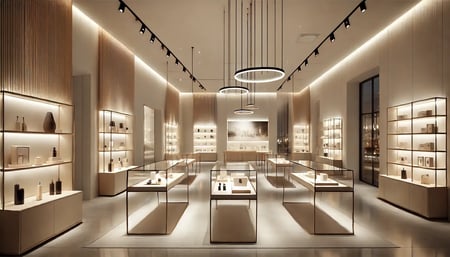Discover how lighting can transform your store and enhance the customer experience.
The importance of lighting in retail
A well thought-out lighting design can completely transform the atmosphere of a store. It is not just about illuminating products, but creating an environment that attracts and retains customers. Lighting can guide the customer through the store, highlight specific products, and create a atmosphere that reflects the brand's identity. In addition, good lighting can influence customers' mood and buying behavior, making the experience more pleasant and memorable.
Types of lighting for different environments
.
There are various types of lighting that can be used in a store, each with a specific purpose. general lighting provides uniform light throughout the space, while accent lighting highlights specific products or areas.  Decorative lighting, on the other hand, adds an aesthetic touch and can help create the desired atmosphere. Each type of lighting should be chosen and placed strategically to achieve the maximum effect.
Decorative lighting, on the other hand, adds an aesthetic touch and can help create the desired atmosphere. Each type of lighting should be chosen and placed strategically to achieve the maximum effect.
For example, LED lights are a popular choice because of their energy efficiency and the ability to adjust color temperature. Accent lights can be used to highlight new arrivals or special promotions, while decorative lights can help create a unique and welcoming environment.
Designing functional and attractive lighting
.
To design functional and attractive lighting, it is essential to consider both aesthetic and practical aspects. Lighting should be strong enough to allow customers to see products clearly, but not so intense as to be annoying. In addition, light distribution should be uniform to avoid unattractive shadows.
Another important aspect is consistency with the theme and style of the store. For example, an upscale fashion store might benefit from warm, soft lighting, while an electronics store might require a cooler, brighter light. The choice of lighting fixtures and their layout must therefore be carefully planned to ensure an optimal shopping experience. Lighting can be a powerful branding tool that can reinforce the store's identity and make the brand more recognizable. The choice of color temperature, light intensity, and lamp design can all help create a consistent and distinctive image.
Technical considerations: energy efficiency and sustainability
In the current context, energy efficiency and sustainability are crucial considerations in retail lighting design. LED technologies, for example, offer energyefficient lighting and have a long lifespan, thus reducing operating costs and environmental impact.
It is also possible to integrate lighting control systems, such as motion sensors and dimmers, to optimize light use and further reduce energy consumption. These systems can automatically adapt to natural light conditions, ensuring that artificial lighting is used only when needed.

The importance of temperature
.
The color temperature is one of the key elements in retail lighting design. warm lights (2700K-3000K) tend to create a welcoming and relaxing atmosphere, ideal for clothing stores, cafes and restaurants. neutral lights (3500K-4100K) are versatile and can be used in a variety of environments, whilecool lights (5000K-6500K) are perfect for spaces that require bright, vivid lighting, such as electronics stores and supermarkets.
In addition to color temperature, it is important to consider the color rendering of lights, which affects how the colors of products are perceived by customers. Good color rendering can make products more attractive and realistic, positively influencing purchasing decisions.
A strategy for success
Light is a silent but key player in the design of a successful retail format. A strategic lighting, thought through down to the smallest detail, can transform space, enhance products, and provide a memorable experience for customers.
For those designing a store, light is not just an aesthetic choice: it is a strategy for success.
